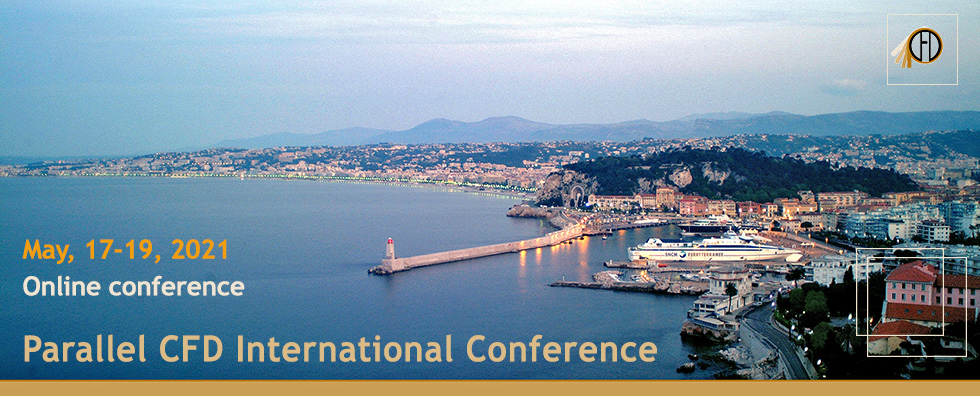Plenary Talks
Invited Plenary Speakers
ParCFD'2021 is honoured to feature the following plenary talks :
|

|
|
Takayuki Aoki
Tokyo Institute of Technology, Japan
Professor, Deputy director, Global Scientific Information and Computing Center.
"AMR-based Simulations for Fluid-Structure Interaction on GPU Supercomputers"
AMR (Adaptive Mesh Refinement) improves the computational efficiency drastically and makes it possible to set outflow boundaries far from ROI. It is also recognized as a key technique for multi-scale studies and suitable for problems of moving interfaces or boundaries. The major difficulties come from data structure, memory management and interpolation at the resolution difference and dynamic domain partitioning to maintain the computational load and used memory balance. An octree-based AMR framework has been developed for GPU supercomputers. We show several implementations of fluid-structure interaction: dolphin free swimming, violent flag fluttering, tsunami flow with a lot of drift woods, expanding soap bubble, in which AMR is needed essentially.
|
|

|
|
Jacqueline Chen
Sandia National Laboratories, USA
Distinguished Member of Technical Staff, Reacting Flows Department
"Towards DNS of Turbulent Combustion at the Exascale"
Direct numerical simulation methodology and computing power have progressed to the point where it is feasible to perform DNS in complex geometries representative of flow configurations encountered in practical combustors. These complex flows encompass effects of mean shear, flow recirculation, and wall boundary layers together with turbulent fluctuations which affect entrainment, mixing, ignition and combustion. Examples of recent DNS studies with complex flows relevant to gas turbine and internal combustion engines will be presented. These include sequential reheat combustion in the presence of mixed combustion modes – hydrogen/air autoignition and flame propagation in a rectangular duct-in-a-duct configuration, turbulent flame propagation of ammonia/hydrogen/nitrogen-air blends in sheared turbulence, and multi-injection autoignition of n-dodecane jets at diesel conditions. In many of these complex flows there are regions of low-intensity turbulence with mean recirculation, flame-wall interaction in boundary layers, and shear generated turbulence interacting with ignition kernels or a flame brush. The U.S. Department of Energy’s Exascale Computing Project is developing applications, software stack and hardware for heterogeneous exascale machines to appear in the 2023 timeframe. Prospects for DNS of complex combusting flows at the exascale will be discussed with an emphasis on finite-volume adaptive mesh refinement with embedded boundary treatment and multi-physics. Finally the prospects of using an asynchronous task based programming model at the exascale to facilitate in situ computational workflows including machine learning and analytics will be discussed.
|
|

|
|
David Keyes
KAUST, Kingdom of Saudi Arabia
Professor, Applied Mathematics and Computational Science
Director, Extreme Computing Research Center
"Scalable Solvers for CFD: Universals and Innovations"
As CFD enters the exascale era, algorithms must span a widening gap between ambitious applications and austere architectures. We present fifteen universals for researchers in scalable solvers and some innovations that allow to approach lin-log complexity in storage and operation count in some important algorithmic kernels, by exploiting hierarchy and data sparsity. Applications are ambitious in many senses: large physical space, phase space or parameter dimensions; resolution of many scales of space and/or time; high fidelity modeling; linking together of multiple complex models; and placement of “forward problems” inside outer loops for inversion, assimilation, optimization, control, or learning. Architectures are austere in several senses, chiefly: low memory per core, low memory bandwidth per core, and low power per operation, which leads to using lower numerical precision where possible and many slower rather than fewer faster cores. Algorithms must adapt to span this gap especially by means that lead to less uniformity and less predetermined schedulability of operations; otherwise, exascale computers will be limited to petascale performance.
|
|
|
|
Pierre Sagaut
AIX Marseille University, France
"Lattice-Boltzmann Method for complex turbulent flow simulation in full scale engineering applications"
The presentation deals with recent development in the design of Hybrid Recursive Regularized Lattice-Boltzmann methods (LBM) for the simulation of turbulent flows in complex geometries, with a broad range of applications ranging from urban physics, evacuation simulation to aerospace engineering. Two key issues are addressed, more precisely 1) accounting for realistic thermodynamics (from perfect gas with compressibility effects to humid air with phase change) while optimizing the numerical efficiency of the method and 2) stabilizing the method while preserving the low-dispersion/low-dissipation feature of the original LBM method. The latter point will be addressed within the Scale Resolving Approach for turbulent flow simulation, and the optimization of the stabilizing procedure for Implicit LES, explicit LES and hybrid RANS-LES methods will be discussed. Since LBM is based on the use of Cartesian grids, the development of efficient immersed boundary techniques along with the coupling with turbulent wall models is a key issue that will be illustrated. During the talk, the emphasis will be put on the researches parformed at the M2P2 laboratory that are implemented in the ProLB software.
|
|
|

|
|
Maria Vittoria Salvetti
University of Pisa, Italy
"Why is it difficult to assess the reliability of LES results? Main issues and possible approaches"
Large-eddy simulation is nowadays considered a high-fidelity approach. However, the assessment of the accuracy and reliability of LES results is a difficult task for different reasons. The first one is that the closure modeling errors in LES are often of the same order as the numerical ones and, hence, they may interact in a complicated manner leading to unexpected effects on the results. Moreover, boundary conditions can also be an issue, since, for instance, at the inlet information on the instantaneous turbulent field is needed, which is often not available in experiments and in real applications . Finally, systematic sensitivity analysis of the impact of modeling and simulation parameters is difficult due to the large computational costs of each single simulation. Different approaches to overcome, at least partially, these issues are reviewed in this talk, and, in particular, those relying on stochastic uncertainty quantification and sensitivity analysis.
|
|

|
|
Pascal Tremblin
CEA, France
Senior scientist, ERC-ATMO Holder, Maison de la Simulation.
"Generalization of the theory of convection and numerical simulations with an all-regime and well-balanced finite volume scheme. Application to thermo-compositional diabatic convection in brown-dwarf and Earth atmosphere"
We present a new conservative finite volume numerical scheme for the study of stratified hydrodynamics that is able to capture both low-Mach and high-Mach flows (all-regime) and hydrostatic equilibrium at machine precision (well-balanced). The scheme is based on a splitting strategy between the acoustic and transport part of the Euler system and can be implemented in a implicit-explicit approach to get rid of the restrictive sound-speed CFL condition while being fully conservative. This new scheme has been implemented using the Kokkos library enabling performance portable across different HPC architectures (CPU, GPU, Manycore).
Using this new solver, we perform numerical simulations of different convective instabilities and show that the presence of source terms are leading to a new family of unstable systems. By generalizing the theory of convection to any type of thermal and compositional source terms (diabatic processes), we show that thermohaline convection in Earth oceans, fingering convection in stellar atmospheres, moist convection in Earth atmosphere, and two-phase convective flows in the cooling systems of nuclear power plants are all deriving from the same general diabatic convective instability. We also show that convection triggered by CO/CH4 chemical transition with radiative transfer in the atmosphere of brown dwarfs and (or other chemical transition in exoplanet atmospheres) is an exact analog of Earth moist convective system.
|
|


